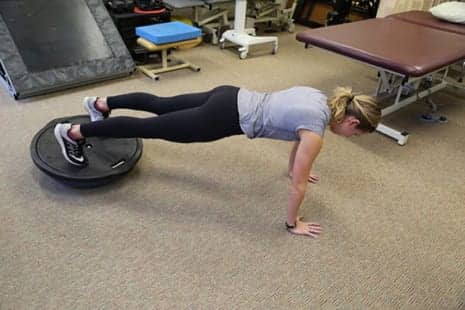
Runners commonly have weak core muscles, which often causes back pain, a recent study suggests. An effective way to strengthen these muscles could be to stabilize one’s body on an unstable surface. For example, perform a plank on a Bosu ball, as shown here. (Photo courtesy of Ohio State University Wexner Medical Center)
Runners with weak core muscles have a higher risk of developing low back pain, according to a study from The Ohio State University Wexner Medical Center and published in the Journal of Biomechanics.
Weak deep core muscles force more superficial muscles like the abs to work harder and reach fatigue faster. When those superficial muscles are doing the work the deep core should be doing, there are often painful consequences, the researchers note.
“When your deep core is weak, your body is able to compensate in a way that allows you to essentially run the same way,” says Ajit Chaudhari, associate professor of physical therapy and biomedical engineering at The Ohio State University Wexner Medical Center, who led the study.
“But that increases the load on your spine in a way that may lead to low back pain,” he adds, in a media release from Ohio State University Wexner Medical Center.
In the study, the researchers used motion detection technology and force-measuring floor plates to examine the role of the superficial and deep core muscles and estimate muscle movements during activity.
“We measured the dimensions of runners’ bodies and how they moved to create a computer model that’s specific to that person. That allows us to examine how every bone moves and how much pressure is put on each joint,” Chaudhari states. “We can then use that simulation to virtually ‘turn off’ certain muscles and observe how the rest of the body compensates.”
Chaudhari recommends that runners perform exercises such as planks that focus on stabilizing the core, especially on unstable surfaces.
“Working on a six-pack and trying to become a better runner is definitely not the same thing. If you look at great runners, they don’t typically have a six-pack but their muscles are very fit,” Chaudhari adds. “Static exercises that force you to fire your core and hold your body in place are what’s really going to make you a better runner.”
[Source(s): Ohio State University Wexner Medical Center, Science Daily]





